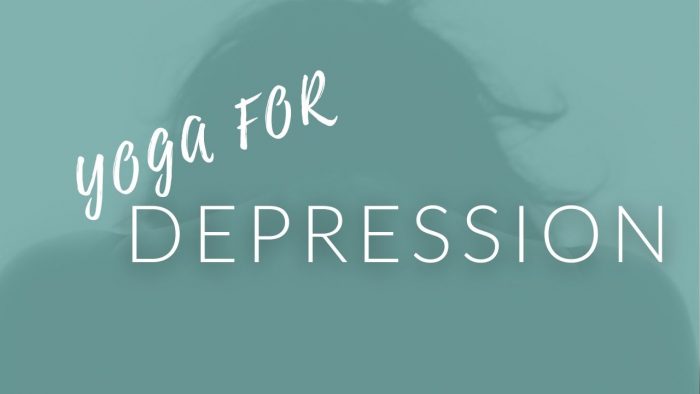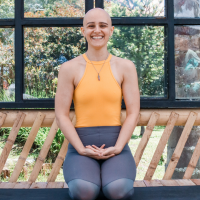There are more than 264 million people in the world suffering from depression. For those individuals that receive professional help, the most common treatment is a combination of antidepressant pharmaceuticals along with psychological counselling.
The problem with pharmaceutical medications is that they have a wide range of side effects. It can also take a great deal of time to figure out the right medication and dosage. Beyond that, many people don’t want to be taking a cocktail of pharmaceuticals for the remainder of their lives.
YOU CAN COMBAT DEPRESSION WITH YOGA
Yoga for depression isn’t a standalone treatment, but it assists in alleviating a number of the symptoms of this very serious and pervasive mental health condition. In addition to short-term relief, the skills learned through a consistent yoga practice can help with symptom management in the long-term.
Sadness is an emotion we all experience. Although it can drain you of energy and make it hard to find pleasure in normally pleasurable activities, it’s an inevitable, unavoidable, and healthy emotional response to various situations and experiences.
Depression, though, is so much more than sadness. Some of the common signs of depression include:
- Tiredness
- Lack of motivation
- Loss of interest in pleasurable activities
- Loss of interest in life
- Feeling hopeless
- Thoughts of self-harm or suicide
- Weight gain or weight loss.
These symptoms pervade every aspect of a person’s life, including their personal, social, and professional life. They might avoid occasions with friends and family, perform poorly at work, and stop practicing hobbies.
Depression is thought to be the result of genetic, biochemical, circumstantial, and psychological factors. In reality, it’s far from being understood, which ultimately means that there is no one solution for treating this condition.
DEPRESSION AND YOGA
The traditional treatment for depression, as mentioned, is a combination of counseling and medication. But only one third of people will find relief in their first attempt with antidepressant medication.
On the other hand, a consistent yoga practice can bring significant relief – and quickly. Researchers and practitioners alike agree that yoga for depression works through the combination of movement (asana), mindfulness (meditation), and breath work (pranayama).
Serotonin – the path to happiness
You’ve probably heard of serotonin. It’s the neurotransmitter that’s responsible for satisfaction, happiness, and optimism.
It’s believed that people with depression have lower serotonin levels than those without. Physical yoga postures are a natural way to increase serotonin production and, therefore, increase your feelings of happiness.
Manage stress with yoga
People with depression have higher levels of the stress hormone, cortisol at all points in the day compared to those without depression.
Cortisol is related to significant changes in the brain and these changes involve the shrinking of the hippocampus and prefrontal cortex, which are responsible for emotion regulation, memory, and decision making. At the same time, it causes the amygdala to become more active, and that’s responsible for our fear and stress response.
Yoga reduces stress hormones, including cortisol and also adrenaline. The breathing exercises, or pranayama, that are essential to yoga are the reason this happens. Pranayama for depression works by inducing the body’s relaxation response, which we’ll talk more about next.
Yoga for intrusive thoughts
The breathwork that is done in a yoga class increases heart rate variability (HRV). HRV is the change in time between heart beats. Higher HRV’s are associated with better self-monitoring and adapting, specifically to stressful situations.
This is what’s known as the relaxation response. When your body enters this state, it’s much easier to sit with your thoughts and emotions. And being able to identify and sit with thoughts and emotions is a key component of identifying triggers for depression.
Increase energy with yoga
A common and problematic symptom of depression is a lack of motivation. During depressive episodes, individuals may lack the energy to partake in activities they once enjoyed, social and professional responsibilities, and experience a general fatigue.
But there are many different types of yoga and quite a few that are gentle and relaxing. These offer an accessible way to begin an exercise regime. And the simple act of participating in exercise can boost energy level, so you have more motivation and energy to continue with the practice.
GET STARTED MANAGING DEPRESSION WITH YOGA
Yoga is an accessible, non-judgemental practice that involves breath, meditation, and physical movement. It’s the combination of these three aspects that make yoga for depression a treatment worth trying.
With that said, severe depressive episodes can make it difficult to perform everyday tasks, such as washing and eating. It’s understandable that attempting to begin yoga while in that state isn’t a realistic expectation. But when the time for healing comes, reach out and let’s talk about how to begin your journey.











Read 0 comments and reply